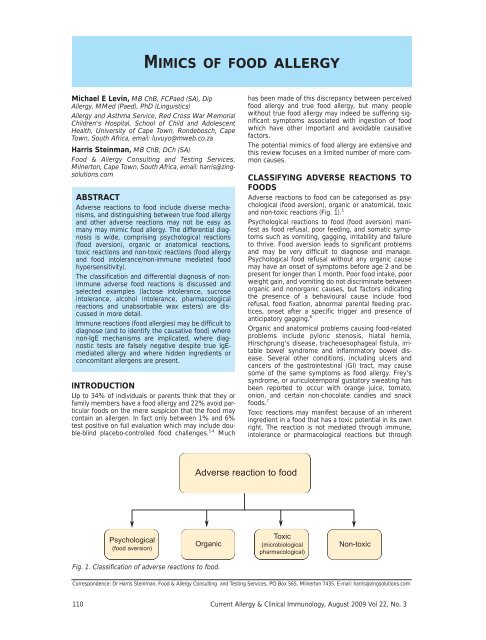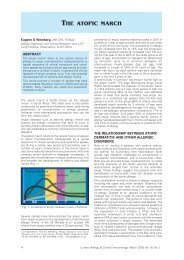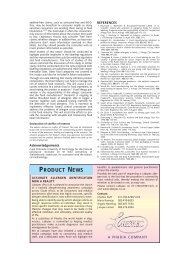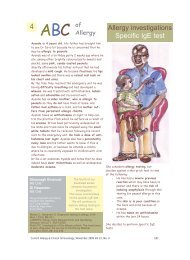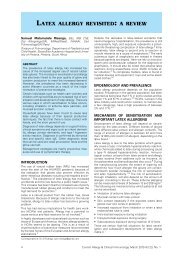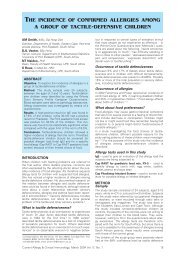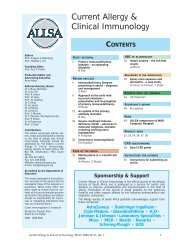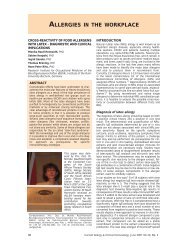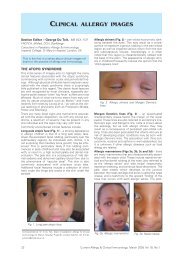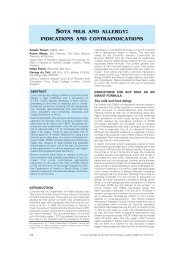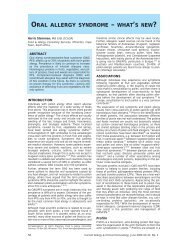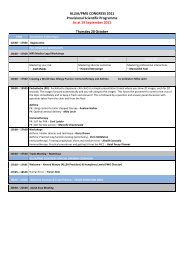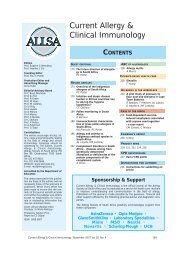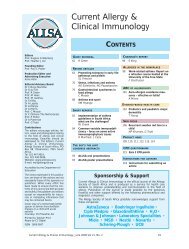Current Allergy & Clinical Immunology - ALLSA
Current Allergy & Clinical Immunology - ALLSA
Current Allergy & Clinical Immunology - ALLSA
Create successful ePaper yourself
Turn your PDF publications into a flip-book with our unique Google optimized e-Paper software.
MIMICS OF FOOD ALLERGY<br />
Michael E Levin, MB ChB, FCPaed (SA), Dip<br />
<strong>Allergy</strong>, MMed (Paed), PhD (Linguistics)<br />
<strong>Allergy</strong> and Asthma Service, Red Cross War Memorial<br />
Children's Hospital, School of Child and Adolescent<br />
Health, University of Cape Town, Rondebosch, Cape<br />
Town, South Africa, email: luvuyo@mweb.co.za<br />
Harris Steinman, MB ChB, DCh (SA)<br />
Food & <strong>Allergy</strong> Consulting and Testing Services,<br />
Milnerton, Cape Town, South Africa, email: harris@zingsolutions.com<br />
ABSTRACT<br />
Adverse reactions to food include diverse mechanisms,<br />
and distinguishing between true food allergy<br />
and other adverse reactions may not be easy as<br />
many may mimic food allergy. The differential diagnosis<br />
is wide, comprising psychological reactions<br />
(food aversion), organic or anatomical reactions,<br />
toxic reactions and non-toxic reactions (food allergy<br />
and food intolerance/non-immune mediated food<br />
hypersensitivity).<br />
The classification and differential diagnosis of nonimmune<br />
adverse food reactions is discussed and<br />
selected examples (lactose intolerance, sucrose<br />
intolerance, alcohol intolerance, pharmacological<br />
reactions and unabsorbable wax esters) are discussed<br />
in more detail.<br />
Immune reactions (food allergies) may be difficult to<br />
diagnose (and to identify the causative food) where<br />
non-IgE mechanisms are implicated, where diagnostic<br />
tests are falsely negative despite true IgEmediated<br />
allergy and where hidden ingredients or<br />
concomitant allergens are present.<br />
INTRODUCTION<br />
Up to 34% of individuals or parents think that they or<br />
family members have a food allergy and 22% avoid particular<br />
foods on the mere suspicion that the food may<br />
contain an allergen. In fact only between 1% and 6%<br />
test positive on full evaluation which may include double-blind<br />
placebo-controlled food challenges. 1-4 Much<br />
has been made of this discrepancy between perceived<br />
food allergy and true food allergy, but many people<br />
without true food allergy may indeed be suffering significant<br />
symptoms associated with ingestion of food<br />
which have other important and avoidable causative<br />
factors.<br />
The potential mimics of food allergy are extensive and<br />
this review focuses on a limited number of more common<br />
causes.<br />
CLASSIFYING ADVERSE REACTIONS TO<br />
FOODS<br />
Adverse reactions to food can be categorised as psychological<br />
(food aversion), organic or anatomical, toxic<br />
and non-toxic reactions (Fig. 1). 5<br />
Psychological reactions to food (food aversion) manifest<br />
as food refusal, poor feeding, and somatic symptoms<br />
such as vomiting, gagging, irritability and failure<br />
to thrive. Food aversion leads to significant problems<br />
and may be very difficult to diagnose and manage.<br />
Psychological food refusal without any organic cause<br />
may have an onset of symptoms before age 2 and be<br />
present for longer than 1 month. Poor food intake, poor<br />
weight gain, and vomiting do not discriminate between<br />
organic and nonorganic causes, but factors indicating<br />
the presence of a behavioural cause include food<br />
refusal, food fixation, abnormal parental feeding practices,<br />
onset after a specific trigger and presence of<br />
anticipatory gagging. 6<br />
Organic and anatomical problems causing food-related<br />
problems include pyloric stenosis, hiatal hernia,<br />
Hirschprung's disease, tracheoesophageal fistula, irritable<br />
bowel syndrome and inflammatory bowel disease.<br />
Several other conditions, including ulcers and<br />
cancers of the gastrointestinal (GI) tract, may cause<br />
some of the same symptoms as food allergy. Frey's<br />
syndrome, or auriculotemporal gustatory sweating has<br />
been reported to occur with orange juice, tomato,<br />
onion, and certain non-chocolate candies and snack<br />
foods. 7<br />
Toxic reactions may manifest because of an inherent<br />
ingredient in a food that has a toxic potential in its own<br />
right. The reaction is not mediated through immune,<br />
intolerance or pharmacological reactions but through<br />
Adverse reaction to food<br />
Psychological<br />
(food aversion)<br />
Organic<br />
Toxic<br />
(microbiological<br />
pharmacological)<br />
Non-toxic<br />
Fig. 1. Classification of adverse reactions to food.<br />
Correspondence: Dr Harris Steinman, Food & <strong>Allergy</strong> Consulting and Testing Services, PO Box 565, Milnerton 7435. E-mail: harris@zingsolutions.com<br />
110 <strong>Current</strong> <strong>Allergy</strong> & <strong>Clinical</strong> <strong>Immunology</strong>, August 2009 Vol 22, No. 3


